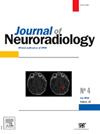机械取栓治疗急性缺血性脑卒中靶血管重合颅内动脉瘤:一项多中心病例对照研究
IF 3
3区 医学
Q2 CLINICAL NEUROLOGY
引用次数: 0
摘要
急性缺血性卒中(AIS)患者机械取栓术(MT)的靶血管上同时存在颅内动脉瘤(CIA)提出了独特的挑战,因为在这种情况下该手术的益处和风险尚不清楚。本研究旨在评估MT在目标血管上有CIA的AIS病例中的疗效和安全性。方法回顾性分析2015年1月至2023年1月期间法国和瑞士14个脑卒中中心的数据。我们确定了接受MT治疗的目标血管上有CIA的AIS病例。对照人群来自ETIS登记处(缺血性卒中血管内治疗),包括同一时期在同一中心接受MT治疗的AIS患者,并在年龄(+年龄)和性别上匹配(1:4)。主要终点是3个月时良好的功能状态,定义为改良的Rankin量表(mRS)评分≤2或等于卒中前mRS。结果共分析了104例mt治疗中至少有一处靶血管CIA的患者和416例mt治疗中没有CIA的患者。CIA组和对照组在3个月时良好的功能结局方面没有观察到显著差异:42.4% vs 41.0%(校正优势比(OR), 1.20;95%CI, 0.72 ~ 1.97)。同样,再通率(MT结束时mTICI≥2b)具有可比性:90.0% vs. 85.9%(调整OR, 1.75;95%CI, 0.77 ~ 3.95)。动脉瘤破裂发生率为5.8%。(图1、2)结论:对于目标血管上有CIA的AIS患者,mt是一种有效的选择,但破裂的风险强调了手术计划的必要性,并考虑转诊到能够处理动脉瘤相关并发症的中心。未来的研究应进一步探索大小和位置标准,以优化患者的选择和定位。本文章由计算机程序翻译,如有差异,请以英文原文为准。
Coincident intracranial aneurysm on the target vessel of acute ischemic stroke treated with mechanical thrombectomy: a multicentric case control study
Introduction
The presence of a coincident intracranial aneurysm (CIA) on the target vessel of patients undergoing mechanical thrombectomy (MT) for acute ischemic stroke (AIS) poses unique challenges, as the benefits and risks of the procedure in this scenario remain unclear. This study aimed to evaluate the efficacy and safety of MT in AIS cases with a CIA on the target vessel.
Methods
We retrospectively analyzed data from 14 stroke centers in France and Switzerland between January 2015 and January 2023. We identified AIS cases with CIA on the target vessel treated with MT. The control population was constituted from the ETIS registry (Endovascular Treatment in Ischemic Stroke), including AIS patients treated with MT in the same centers during the same period, and were matched (1:4) on age (+-year) and sex. The primary outcome was favorable functional status at 3 months, defined as a modified Rankin Scale (mRS) score ≤ 2 or equal to pre-stroke mRS.
Results
A total of 104 MT-treated patients with at least one CIA on the target vessel and 416 MT-treated patients without CIA were analyzed. No significant differences were observed in favorable functional outcome at 3 months between the CIA and control groups: 42.4% vs. 41.0% (adjusted odds ratio (OR), 1.20; 95%CI, 0.72 to 1.97). Similarly, recanalization rates (mTICI ≥ 2b at end of MT) were comparable: (90.0% vs. 85.9% (adjusted OR, 1.75; 95%CI, 0.77 to 3.95). Aneurysm rupture occurred in 5.8% of cases. (fig. 1, 2)
Conclusion
MT is an effective option for AIS patients with CIA on the target vessel, but the risk of rupture underscores the need for procedural planning and consideration of referral to centers capable of managing aneurysm-related complications. Future studies should further explore size and location criteria to optimize patient selection and orientation.
求助全文
通过发布文献求助,成功后即可免费获取论文全文。
去求助
来源期刊

Journal of Neuroradiology
医学-核医学
CiteScore
6.10
自引率
5.70%
发文量
142
审稿时长
6-12 weeks
期刊介绍:
The Journal of Neuroradiology is a peer-reviewed journal, publishing worldwide clinical and basic research in the field of diagnostic and Interventional neuroradiology, translational and molecular neuroimaging, and artificial intelligence in neuroradiology.
The Journal of Neuroradiology considers for publication articles, reviews, technical notes and letters to the editors (correspondence section), provided that the methodology and scientific content are of high quality, and that the results will have substantial clinical impact and/or physiological importance.
 求助内容:
求助内容: 应助结果提醒方式:
应助结果提醒方式:


